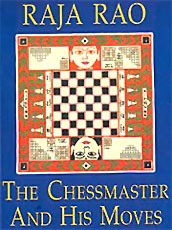 Awarded with the Neustadt International Prize for Literature, `The Chessmaster and His Moves` was published in 1988 for the first time. It was the first volume of a trilogy expressed in a style. Rao tried to explain the game of chess with life. In his story the horses, elephants, chamberlains and kings, which might fight with one another so the title of the story aptly describe the storyline that is clearly understandable.
Awarded with the Neustadt International Prize for Literature, `The Chessmaster and His Moves` was published in 1988 for the first time. It was the first volume of a trilogy expressed in a style. Rao tried to explain the game of chess with life. In his story the horses, elephants, chamberlains and kings, which might fight with one another so the title of the story aptly describe the storyline that is clearly understandable.
Raja Rao was born on November 8, 1908 in Hassan, in the state of Mysore in south India, into a well-known Brahman family. His native language was Kanarese, but his post-graduate education was in France, and all his publications in book form have been in English. From the very beginning Rao has been concerned with language and consciousness. Rao was educated at Muslim schools. After taking a degree from Madras University, he left India for Europe, where he remained for a decade. He studied at the universities of Montpellier and the Sorbonne, doing research in Christian theology and history. In 1931 he married a French academic, Camille Mouly who left a mark in his life even after their separation. His first stories Rao published both in French and English. During 1931-32 he contributed four articles written in Kannada for `Jaya Karnataka`. It was an influential journal of that region. As a writer, Rao`s concern is with the human condition rather than with a particular nation or ethnic group. He describes the human nature in an awesome way. He enabled modern readers of English to experience the spiritual depths of Indian culture. All his works involve a search for the fundamental reality in life, which led him to an investigation of the very nature of writing. Raja Rao wrote of the higher spiritual necessities of man as well as the everyday realities of life. He looked at the social concerns in his short stories, particularly in the earlier phase of his writing career. In one of his stories the plight of a child-widow in an orthodox society has been shown in a explicit way while in another story he evokes the village atmosphere and portrays the travails of a low-caste servant woman.
Synopsis:
`The Chessmaster and His Moves` published in 1988 is peopled by characters from various cultures seeking their identities. In this novel Rao used the metaphor of the chess game to animate philosophical and psychological ideas. In the story Sivaram Sastri, an Indian mathematician in Paris, meets Proust, and recounts his love affairs and friendships. Rao has confessed in one of his meetings: "I am no scholar. I am a creative writer. I love to play with ideas. It is like a chess game with horses, elephants, chamberlains and kings which might fight with one another. The game is not for winning. It is for rasa-delight." `The Chessmaster and His Moves` itself contains three books spread over 700 odd pages. The Chessmaster is the story of an impossible love between Sivarama Sastri, an Indian mathematician working in Paris, and a married woman. The story is full of uncertainty with no ending and can only end in sorrow and desperation. To come to terms with its impossibility, the protagonists turn inward in their search for answer and meaning, transforming the book into a metaphysical exploration. Amidst this search they get involved in various search big or small. Sastri`s love for the French actress, Suzanne Chantereux, or her beguiling, effervescent compatriot Mireille, for instance, serves to underline the differences between the East and West; while the latter seeks happiness in the world, Sastri is looking for freedom from the world itself.
The famous publication house named vision books published `The Chessmaster and His Moves` in 1988.
`The Chessmaster and His Moves` by Raja Rao is very rich in language. Its plot as well as its large cast of memorable characters; Indian, European, African and Jewish possess a remarkable character. The book never gives a serious feel as it is filled with laughter and delight in addition to tragic and sensuous at times. The story moves from France to London, and on to the Himalayas and Bengal. The book contains the conversation between a Brahmin and a Rabbi for the first time ever in a literary work.



















